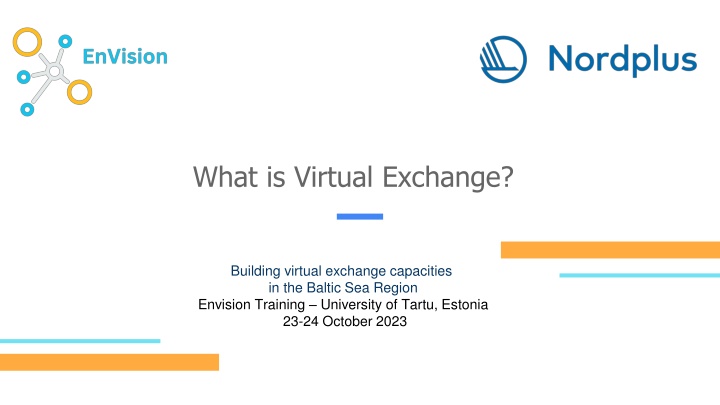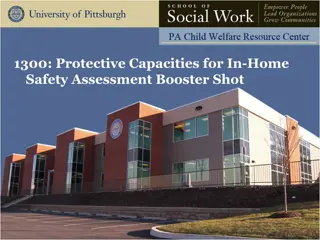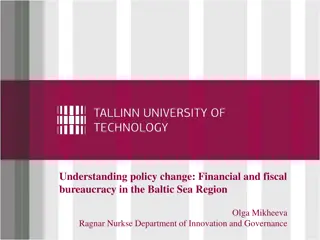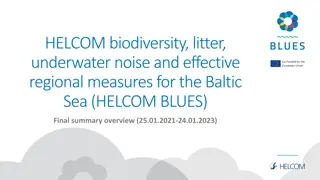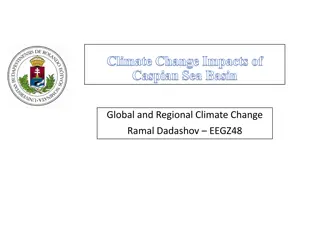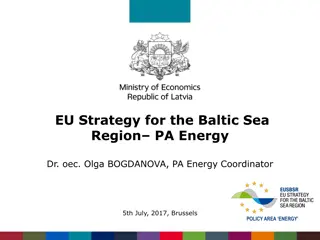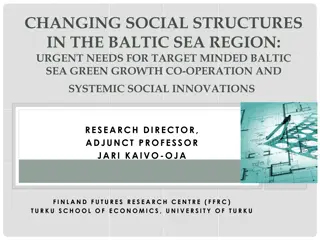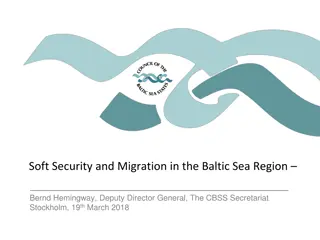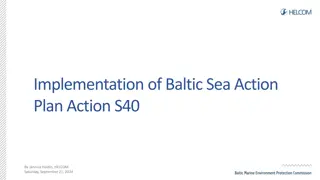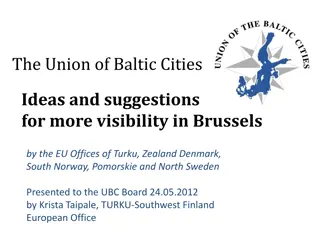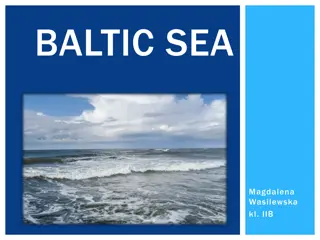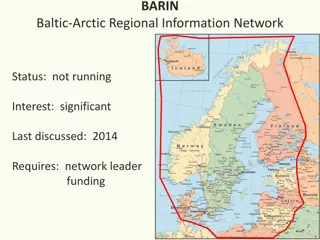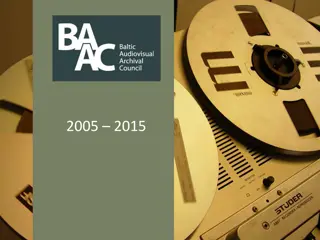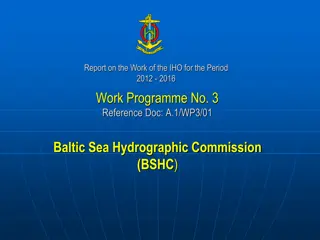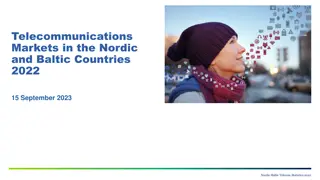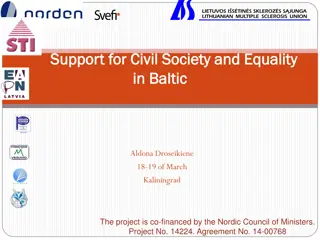Building Virtual Exchange Capacities in the Baltic Sea Region at Envision Training
The concept of Virtual Exchange, a pedagogical approach facilitating deep social learning, reciprocity, and meaningful interactions between students. Discover its differences from other online learning forms and grasp the nuances of virtual mobility vs. virtual exchange models. Delve into various models of Virtual Exchange, including Co-Designed and Ready-made options. Witness how Virtual Exchange prepares, deepens, and extends physical exchanges while promoting inclusivity and competency building.
Download Presentation

Please find below an Image/Link to download the presentation.
The content on the website is provided AS IS for your information and personal use only. It may not be sold, licensed, or shared on other websites without obtaining consent from the author.If you encounter any issues during the download, it is possible that the publisher has removed the file from their server.
You are allowed to download the files provided on this website for personal or commercial use, subject to the condition that they are used lawfully. All files are the property of their respective owners.
The content on the website is provided AS IS for your information and personal use only. It may not be sold, licensed, or shared on other websites without obtaining consent from the author.
E N D
Presentation Transcript
What is Virtual Exchange? Building virtual exchange capacities in the Baltic Sea Region Envision Training University of Tartu, Estonia 23-24 October 2023
What is Virtual Exchange? o Pedagogical approach developed over the last 3 decades from experience in the field of language education, educational exchange and study abroad o Technology-enabled, people-to-people, sustained over a period of time o Use of media platforms to enable deep, interactive social learning (not simply to deliver content) o Interactions between students are facilitated to ensure they are meaningful o Promotes reciprocity and allows for equity and inclusiveness o Prepares, deepens, and extends physical exchanges, and can fuel new demand for physical mobility
What Virtual Exchange is NOT Virtual Exchange Other forms of online learning Emphasis on people to people, intercultural dialogue and/or collaboration Emphasis on online access to university course content (video lectures etc.) Educators/facilitators guide interaction between learners in different locations Educators provide educational content to learners Intercultural learning is one of the main educational outcomes in addition to course content Mastery of course content is main (and sometimes only) educational outcome Usually includes synchronous video communication with peers in small groups Communication is predominantly asynchronous
Virtual Mobility vs Virtual Exchange Virtual mobility the use of information and communication technologies (ICT) to obtain the same benefits as one would have with physical mobility but without the need to travel (Bijnens, Boussemaere, & Rajagopal, 2006, 20 p. 5) and focuses on the cooperation of educational institutions as well as the recognition of achievements. Virtual exchange [...] is centred on the interaction and communication of geographically separated participants (Virtual Exchange Coalition, 2019). Instead of access to educational offers of cross-border universities, the focus is clearly on exchange, competence building, and interaction in small groups (European Commission, 2018). Administrators implementing these concepts in higher education are confronted with a variety of organisational, didactic, and administrative challenges. (Schoop, Clauss & Askbar Safavi, 2020, pp. 19-20)
Different Models of Virtual Exchange a) Co-Designed o 2+ professors (and their support staff) adapt parts of their existing courses to host a period of collaboration between students o training, support and mentoring are recommended b) Ready-made o experienced VE providers (e.g. Soliya and Sharing Perspectives Foundation) offer programmes on various topics o individual students may join, or one of these programmes can be integrated into the curriculum
How can VE be integrated into the curriculum? 1 VE as a preparatory or follow-up activity to physical mobility (blended mobility) 2 VE as an intertwined component of a physical mobility (blended mobility) VE either before/after mobility exchange VE intertwined with physical mobility into a single educational experience Great for: Offering high quality preparation for physical mobility, and ensuring that students make the most of their stay abroad or reflect on their international experience. Great for: Diversifying the participating student body of a physical mobility, by including students who are unable to travel for longer periods of time. 3 VE as a stand-alone learning activity 4 VE as a component of a course (traditional/online) VE recognised as an individual activity Great for: Institutions to introduce VE projects centrally with more limited teaching staff involvement if desired. VE as integral & required part of the course Great for: Teaching staff who wish to give their course an international dimension, either by integrating a VE project co-designed by the teachers, or by including a ready-made VE within a single course.
Why integrate a VE into the curriculum? Employability: graduate attributes Transversal skills Communication skills Ability to work in groups Problem-solving Work in culturally diverse setting Digital competences Critical thinking Global competence https://lydia-arnold.com/2016/10/03/the-process-of-defining-graduate-attributes/
Inclusion International student mobility is for a minority of students, a cultural elite EC objective for 2020 was to involve 20% student population in a mobility programme. What about the remaining 80%?
Can these goals be achieved without transnational, transdisciplina ry collaboration ?
Terminology COIL Telecollaboration Collaborative Online International Learning Global Classroom International Virtual Classroom Global Learning Experience
Example Podcast Production Medical Anthropology SUNY New Paltz (NY, USA) American University of Cairo (Egypt) (1) experience working with people from a different culture (1) Gain appreciation for research on a topic that they probably won't get to select (2) gain experience working in a different medium (potentially producing audio podcasts rather than a traditional research/term paper) (2) work on a collaborative project and develop soft skills (3) broaden the perspective offered in the course (which focuses principally on examples of social inequality and its impact on health in the United States) (3) gain an understanding of how the media production process works
SUNY COIL Stevens Initiative Assessment White Paper (Guth & Helm 2017)
Benefits of Co-Designed VE Students Gain knowledge regarding course content through peer perspectives Learn to collaborate online in international teams as well as other soft skills Teachers Add an enriching international component to their course Customise a VE to their specific desired learning outcomes Learn innovative pedagogical approaches to education Strengthen partnerships
Questions? Thank you! ana.beaven@unicollaboration.org
